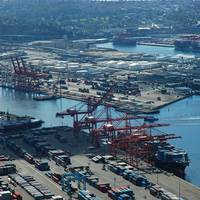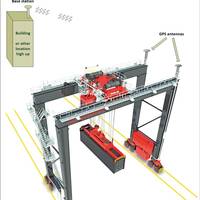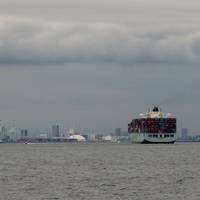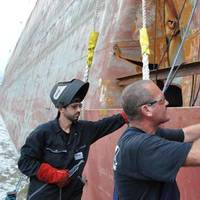First Ship Departs Baltimore Through Limited Access Channel

The first commercial vessel transited through a newly opened channel in the Port of Baltimore following the deadly collapse of the Francis Scott Key Bridge.The Fort McHenry Limited Access Channel (LAC) was opened as a temporary solution to provide passage for a limited number of commercial vessels into the Port of Baltimore and a departure opportunity for some deep draft vessels currently unable to leave the harbor since the bridge collapse.The channel—the fourth to be opened…
NVOCCs Caught in the Middle of Ocean Shipping Reform Act

NVOCCs are caught in the middle of the Ocean Shipping Reform Act of 2022 requirements for reporting demurrage and detention; FMC needs to pump the brakes and allow the industry to catch upThe Ocean Shipping Reform Act of 2022, passed by Congress without industry input and signed into law on June 16, has left the industry in a difficult position regarding how to comply with the new requirements for invoicing demurrage and detention (D&D) charges.At issue is the Container Availability Date…
'Containergeddon': Supply Crisis Drives Walmart and Rivals to Hire Their Own Ships
The Flying Buttress once glided across the oceans carrying vital commodities like grain to all corners of the world.Now it bears a different treasure: Paw Patrol Movie Towers, Batmobile Transformers and Baby Alive Lulu Achoo dolls.The dry bulk cargo ship has been drafted into the service of retail giant Walmart, which is chartering its own vessels in an effort to beat the global supply chain disruptions that threaten to torpedo the retail industry's make-or-break holiday season."Chartering vessels is just one example of investments we've made to move products as quickly as possible," said Joe Metzger, U.S. executive vice president of supply-chain operations at Walmart…
Tech Files: Breathing New Life into Old Port Cranes

Retrofits of new features into existing ports cranes can produce operational efficiency and safety gains not included on cranes delivered 15-20 years ago, including Ship-to-Shore (STS) Rubber Tyred Gantry (RTG) and Rail Mounted Gantry (RMG) types. Here, Dmitry Lapin, Knowledge and Development Manager, Port Services, Konecranes, looks at retrofit options proven in applications internationally.Sooner or later, the owners of ports cargo handling equipment are going to face a number of technical and organizational questions about the future.
Adoption of LNG as Marine Fuel Significantly Accelerated in 2017
Titan LNG says that the stage has been set for a push in the adoption of LNG as a marine fuel beyond the tipping point. The order book for LNG-powered ships grew substantially, the LNG bunkering infrastructure is maturing and the pricing of LNG has become structurally competitive versus MGO. In 2017 around 11% of all new build contracts were LNG powered ships, a trend that we expect to continue during 2018. Titan LNG is very pleased with these developments and we are proud to be at the forefront of this market. LNG Truck-to-Ship bunkering, and from next year on with our LNG bunkering pontoon, the FlexFueler 001 makes LNG readily available, therewith paving the way for more orders of LNG powered vessel.
Connecting Boatbuilders to the New Gold Standard
Victaulic’s forward-thinking vertical integration remains, at the same time, solidly connected to a rich and varied past. It is still common to hear waterfront stakeholders refer to alternative pipe connection systems as temporary or simply as ‘a new development.’ While none of that could be further from the truth, the education of the marine community as to the merits of these products as an alternative to traditional flanges continues. These products – like Victaulic’s market offerings – are indeed mainstream parts of the marine sector, their use limited only by the imagination of designers, builders and operators who constantly find new applications to improve their bottom line. Since the 1920s, Victaulic couplings have demonstrated their value in countless maritime applications.
Marine Piping: It's Not Rocket Science
Anything but unconventional, Viega piping products and systems provide uncommon time savings and safer repairs, leading to a better bottom line. The maritime industry, over time, has been unusually resistant to change in many aspects of how it operates. Arguably, the ‘biggest’ advances on the water spanning a five decade period leading up to the beginning of the new millennium could be measured in terms of deadweight tonnage and/or the length of a particular class of hulls. Nowhere is that reality more evident than in the shipyard, and looking at what equipment and hardware is used to build and repair marine vessels – now and in the past. Marine piping systems are a perfect example.
Container Ship Industry ‘Lucky to Break Even' in 2015,
Global shipping consultancy Drewry predicts the container ship industry will be "lucky to break even this year" as shipping rates slump due to catastrophic overcapacity. A toxic mixture of overcapacity, weak demand and aggressive commercial pricing is threatening liner shipping industry profitability for the rest of 2015. Drewry’s new view of the market revises its earlier forecast that carriers would collectively generate profits of up to $8 billion in 2015. Drewry now says that its revised view is that carriers “will be lucky to break even this year,” meaning some lines will be back in the red by year-end. Despite first quarter industry operating margins of 8%, cost savings through falling oil prices were passed onto shippers by carriers in the form of much lower freight rates.
Container Shipping Lucky to Break Even in 2015

A toxic mixture of overcapacity, weak demand and aggressive commercial pricing is threatening liner shipping industry profitability for the rest of 2015, according to the Container Forecaster report published by global shipping consultancy Drewry. Earlier this year Drewry forecast that container shipping carriers would collectively generate profits of up to $8 billion in 2015, but our revised view is that it will be lucky to break even this year. This means that some lines will be back in the red by the end of 2015.
Floating LNG Regasification is Used in Smaller Markets
According to the latest research from the US Energy Information Administration (EIA), floating LNG (FLNG) regasification is being used to meet rising natural gas demand in smaller markets. Floating regasification is a flexible, cost-effective way to receive and process shipments of LNG. It is increasingly being used to meet natural gas demand in smaller markets, or as a temporary solution until onshore regasification facilities are built. Of four countries planning to begin importing LNG in 2015, three of them—Pakistan, Jordan, and Egypt—have chosen to do so using floating regasification rather than building full-scale onshore regasification facilities.
Emergency On-site Repairs Keeps Vessel Sailing

Hydrex offers fast on-site repairs in emergency situations. Its fast response team are ready to mobilize immediately to locations around the world for a wide range of operations. There are many events that can stop a ship from sailing. Ships with a leaking stern tube are often not allowed to enter ports. A vessel can be tied up after a collision or a malfunctioning rudder can prevent safe maneuvering. Going to drydock is obviously not an option in such cases. Arranging the vessel to be unloaded at sea is an organizational and financial disaster for the owner.
China's Nine Dash Line and the Law of the Sea: Kemp
Territorial disputes over tiny islands and reefs in the South China Sea are poisoning relations between China and its neighbours in Southeast Asia. "In recent months, China has undertaken destabilising, unilateral actions asserting its claims in the South China Sea," U.S. Defense Secretary Chuck Hagel told an audience in Singapore last month. "(China) has restricted access to Scarborough Reef, put pressure on the long-standing Philippine presence at the Second Thomas Shoal, begun land reclamation activities at multiple locations, and moved an oil rig into disputed waters near the Paracel Islands," Hagel complained at the Shangri-La Dialogue.
Offshore Platform 'Siri' for Repair Despite Cost Increase
Dong Energy is implementing a permanent repair solution necessary to restore the integrity of the Danish North Sea platform Siri. The background for the repair work is that DONG Energy during a routine inspection in August 2009 discovered cracks in the nose of the subsea oil tank of the Siri platform. No pollution happened but the production was shut down for five months as a safety measure and re-started January 2010 after a temporary solution had been installed. Following the progress of the project, the repair cost estimate has been increased from the initial expected DKK 2 billion to DKK 3.5 billion of which DKK 0.6 billion was incurred in 2011.
Propulsion Software May Allow Ferry to Begin Service
Officials with the Washington State Department of Transportation Ferries Division said that changes to software controlling the propeller system on the new Chetzemoka ferry may provide a temporary solution to vibration issues first discovered last month. Additional sea trials are scheduled for the middle of next week after representatives of the propulsion-control company write software exerting greater control over the engine “ramping,” which allows the bow propeller to slow the ship as it approaches the dock. The goal is to ramp up the propeller speed over a period of a few seconds longer, as opposed to a more sudden and quick thrust of power.
Noreq Aids Greek Cruise Ship
On August 7, the cruise ship Thomson Spirit collided with another cruise ship, Ocean Majesty - on the Geirangerfjord in Norway. A lifeboat and the davit for a tender vessel were damaged which resulted in Ocean Majesty being refused permission to continue its cruise. No passengers or crew were injured. Noreq AS, a Norwegian manufacturer and equipment supplier, helped the Greek shipping company. A temporary solution was found in record time, and the ship was allowed to continue its voyage to Iceland. The solution was to installa new life-raft davit, ensuring the necessary safety until the shipping company is able to repair or replace the damaged lifeboat and davits.












